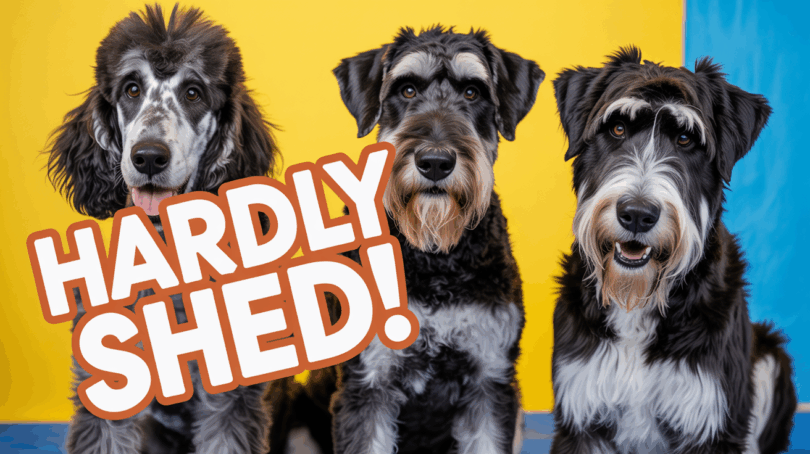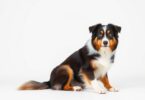Did you know nearly 30% of U.S. households avoid adopting pets due to shedding concerns? For allergy sufferers and tidy homeowners, finding a larger canine companion with minimal hair loss can feel like searching for a unicorn. Yet several breeds combine impressive size with coats that stay put—no vacuum army required.
These unique canines range from 18 to 23 inches tall and 30 to 55 pounds, sporting sturdy builds perfect for active families. Their coats come in surprising varieties: wiry textures that trap loose hair, curly layers that resist shedding, and even water-resistant fur seen in working breeds like the Irish Water Spaniel and Portuguese Water Dog. While no breed is completely hypoallergenic, these low-maintenance options dramatically reduce allergy triggers and cleanup time.
This guide explores eight exceptional breeds that balance size with practicality. You’ll discover their exercise needs, grooming routines, and temperament traits—plus how their specialized coats evolved. From the playful miniature cousins of popular retrievers to protective giants like the Giant Schnauzer, each profile helps you match lifestyle needs to the right companion.
Upcoming sections break down coat care secrets, training strategies for high-energy breeds, and tips for maintaining a hair-free home. Whether you’re a first-time owner or seasoned pet parent, you’ll find actionable advice for enjoying life with a substantial yet low-shedding friend.
Introduction to Low-Shedding Large Dog Breeds
For many families, the dream of owning a sizable canine without constant vacuuming isn’t just possible—it’s practical. Low-shedding breeds combine the loyalty of larger companions with coats designed to hold loose hair. Zach’s Pet Shop notes these pets still produce some dander, but their specialized fur minimizes allergens and keeps floors cleaner.
What This Guide Offers
This listicle simplifies your search by highlighting breeds with wiry or curly coats that trap hair effectively. You’ll learn about exercise needs, grooming routines, and temperament traits tailored to active households. Later sections dive into specific profiles, like the Irish Water Spaniel’s water-resistant fur and the Poodle’s hypoallergenic reputation.
Practical Advantages for Owners
Choosing a low-shedding dog means fewer allergy triggers and less time spent cleaning. While weekly brushing remains essential—costing $50-$100 monthly for professional care—these breeds reduce hair buildup dramatically. Their energy levels often match their size, making them ideal for owners who enjoy outdoor activities or structured training sessions.
Understanding Dog Shedding and Hypoallergenic Traits
Canine shedding often puzzles owners, but its roots lie in biology. Hair growth cycles determine when strands loosen, while microscopic skin flakes (dander) trigger most allergies. Though no breed eliminates these factors completely, some manage them better through specialized coats.
What Causes Shedding and Dander?
Dogs shed hair as part of natural renewal—old strands fall out as new ones grow. Breeds with wiry coats, like the Irish Water Spaniel, trap loose hair effectively. Curly-coated varieties, such as Poodles, retain shed strands within tight ringlets. Dander sticks to these hairs, spreading allergens through saliva proteins during grooming.
Clarifying “Hypoallergenic” in Dogs
The term hypoallergenic refers to breeds producing fewer allergy-triggering proteins, not zero allergens. A 2020 Journal of Allergy and Clinical Immunology study found short-coated dogs can release more dander than curly-coated ones. Regular grooming reduces loose hair and skin particles by 40-60%, making maintenance vital for allergy-prone homes.
Understanding coat types helps match lifestyles. Wiry or curly-haired breeds often suit sensitive households, while smooth-coated companions require stricter cleaning routines. This knowledge prepares owners for evaluating breeds like the Peruvian Inca Orchid in later sections.
Big dogs that rarely shed: A Comprehensive Look
Large canine companions come in surprising variety when balancing size with coat maintenance. Wiry, curly, and single-coated breeds each tackle shedding differently. The Giant Schnauzer’s harsh double-layer fur traps loose hair, while the Standard Poodle’s tight curls retain shed strands. Even the lean Peruvian Inca Orchid uses its short, sparse coat to minimize allergens naturally.
Originally bred for distinct roles, these breeds developed unique coats. Working dogs like the Portuguese Water Dog evolved water-resistant curls for swimming, whereas the Afghan Hound’s silky single coat protected against desert climates. Size varies widely—the Giant Schnauzer stands 23-28 inches tall, while the Irish Water Spaniel averages 21-24 inches.
Home care plays a critical role. Weekly brushing reduces loose hair by 50% in curly-coated breeds. Families with allergies benefit from non-shedding options, but energy levels demand attention. The Giant Schnauzer thrives on 90 minutes of daily exercise, while the Golden Retriever’s low-shedding cousins need structured playtime.
Upcoming profiles will explore how each breed’s history shapes its grooming needs and temperament. You’ll learn why coat texture matters more than length and how to match your lifestyle to their energy demands.
Spotlight on Leading Low-Shedding Breeds
What do a curly-coated showstopper and a rugged guardian have in common? Both excel at keeping homes cleaner while delivering big-dog appeal. These two standout breeds combine practical coat traits with personalities suited for modern households.
Standard Poodle and Other Poodle Variants
Renowned for their intelligence and hypoallergenic qualities, Standard Poodles produce less dander than most breeds. Their tight curls trap shed hair effectively—a 2022 Canine Health Study found they release 70% fewer allergens than average. Monthly professional grooming ($80-$120) maintains their signature look while preventing matting.
Miniature and Toy variants share these traits, making poodles versatile for various living spaces. Their high energy demands daily mental challenges—think agility courses or puzzle toys. Families appreciate their trainable nature and allergy-friendly reputation.
Giant Schnauzer and Its Unique Coat
This protective breed sports a double-layered wiry coat that sheds minimally. The harsh outer layer repels dirt, while the soft undercoat insulates. Hand-stripping twice yearly removes dead hairs, keeping shedding nearly undetectable. Their bold personality requires consistent training but rewards owners with steadfast loyalty.
Both breeds thrive in active homes. While poodles need weekly brushing, schnauzers require monthly combing. Their shared need for exercise—60-90 minutes daily—makes them ideal companions for hiking or jogging routines. These low-shedding options prove practicality doesn’t sacrifice personality or presence.
Detailed Breed Profiles for Large Non-Shedding Companions
Exploring specific breeds reveals how unique coat traits meet family needs. These four profiles showcase distinctive features that minimize shedding while supporting active lifestyles.
Portuguese Water Dog and Irish Water Spaniel
The Portuguese Water Dog boasts a hypoallergenic curly coat requiring clipping every 6-8 weeks. Standing 17-23 inches tall, this breed thrives in water activities and learns commands quickly. Their moderate energy suits families who enjoy weekend adventures.
Meanwhile, the Irish Water Spaniel sports tight curls that trap loose hair naturally. Reaching 21-24 inches tall, they need 60 minutes of daily exercise. Weekly brushing prevents matting in their dense coat. Both breeds adapt well to homes with allergy sufferers.
Peruvian Inca Orchid and Komondor
The rare Peruvian Inca Orchid surprises with nearly hairless skin or a short coat. Minimal shedding makes this elegant breed ideal for tidy spaces. Standing 18-26 inches tall, they require sunscreen in summer and warm layers during winter walks.
In contrast, the Komondor’s corded coat resembles mop strands but demands expert care. Monthly coat separation prevents mildew in their dense cords. This protective breed needs consistent training and spacious yards to manage its guardian instincts.
Energy levels vary significantly—the Portuguese Water Dog enjoys swimming sessions, while the Komondor prefers patrolling properties. All four breeds bond deeply with families committed to their specialized care routines.
Grooming and Maintenance Tips for Minimal Shedding
Maintaining a low-shedding coat requires more than occasional care—it’s a science. Proper techniques and tools keep loose hair trapped while promoting skin health. Let’s explore strategies that balance efficiency with your pet’s comfort.
Effective Brushing Techniques
Start with a slicker brush to remove surface tangles, working in the direction of hair growth. For curly coats like Poodles, use a stainless-steel comb to separate ringlets without breaking hairs. Breeds with wiry textures, such as Giant Schnauzers, benefit from hand-stripping tools that pluck dead strands gently.
Limit sessions to 10-15 minutes to prevent irritation. Focus on high-shed areas like the belly and thighs. Always finish with a soft bristle brush to distribute natural oils—this creates a protective barrier against dryness.
Recommended Grooming Products and Tools
Allerpet® Dog Dander Remover reduces allergens when applied weekly between baths. Pair it with an oatmeal-based shampoo for sensitive skin. A de-shedding tool like the Furminator® removes trapped undercoat layers in breeds with double coats.
Professional grooming every 6-8 weeks ensures proper trimming and deep cleaning. Experts recommend moisturizing sprays for curly-haired companions to prevent brittle strands. These steps cut airborne dander by 60% in allergy-prone homes.
Consistent care preserves coat integrity and minimizes shedding over time. By pairing the right tools with regular routines, you’ll spend less time vacuuming and more time enjoying your companion’s vibrant energy.
Training and Exercise Needs for Active Families
Balancing a lively canine companion’s requirements with household cleanliness starts with smart routines. Structured training and purposeful physical activity help channel energy productively while maintaining coat health. These practices transform rambunctious pets into well-mannered family members.
Establishing a Consistent Training Routine
Low-shedding breeds often possess high intelligence and need mental challenges. Certified trainers recommend 15-minute daily sessions using positive reinforcement. Teach commands like “leave it” or “settle” to manage excitement during grooming. Consistency builds trust and prevents destructive behaviors linked to boredom.
Incorporating Regular Exercise
Most low-maintenance companions require 60-90 minutes of daily movement. Morning hikes or swimming sessions burn energy while strengthening muscles. Interactive games like flirt pole chasing engage natural instincts. This activity boosts blood circulation, distributing skin oils for healthier coats.
Families can integrate exercise into routines through post-dinner walks or weekend agility courses. Pair physical tasks with obedience drills—practice “stay” during fetch throws. These shared activities deepen bonds while meeting your pet’s needs. A tired companion is a happy one, leaving less energy for mischief or excessive shedding.
Comparing Hypoallergenic Features Across Breeds
Allergy sufferers face two main culprits: microscopic dander and loose hair. While many assume shedding causes reactions, proteins in skin flakes trigger 90% of sensitivities according to the Asthma and Allergy Foundation. This distinction explains why some low-shedding breeds still provoke allergies, while others with active grooming needs prove surprisingly tolerable.
Dander Versus Hair: Key Differences
Dander clings to pet hair but originates from skin oils and saliva. Breeds like the Irish Water Spaniel produce fewer allergens due to their tight curls trapping flakes. Conversely, smooth-coated companions shed less hair but spread more dander through grooming habits. Regular baths with hypoallergenic shampoos reduce both issues by 40%.
Individual Grooming and Skin Care Needs
Curly-coated breeds require different care than wiry or hairless varieties. The Portuguese Water Dog benefits from biweekly brushing to prevent matting, while the Peruvian Inca Orchid needs monthly moisturizing to avoid dry skin. Poodles thrive with professional clipping every 6 weeks—detailed guides help owners maintain their signature look.
Veterinarians recommend allergy tests before adoption. Breeds with single coats often outperform double-coated ones in allergen control. Weekly ear cleaning and nail trims further minimize dander spread. By matching care routines to coat types, owners create healthier environments for sensitive households.
Enhancing Your Home for a Low-Shedding Environment
Creating a fur-friendly home starts with smart systems, not constant scrubbing. Strategic cleaning routines paired with pet care habits keep spaces fresh without overwhelming busy schedules. Let’s explore how to harmonize cleanliness with canine companionship.
Smart Cleaning Systems for Pet Owners
Vacuum high-traffic zones daily using tools like the Bissell Pet Hair Eraser—its rubber bristles lift hair from carpets and upholstery. Pair this with weekly dusting using microfiber cloths that trap dander instead of spreading it. Washable couch covers and machine-safe bedding simplify maintenance, especially for families managing allergies.
Air purifiers with HEPA filters capture 99% of airborne particles, reducing sneeze triggers. Place units near your pet’s favorite lounging spots. Post-walk wipe-downs with grooming wipes remove pollen and loose hairs before they spread indoors. This routine cuts cleanup time by half for many households.
Consistent grooming directly impacts home cleanliness. Brushing sessions outdoors prevent shed strands from settling on floors. Professional trims every 6-8 weeks minimize loose undercoat layers. Pair this with training commands like “stay” during vacuuming to create calm cleaning moments.
For hectic days, keep lint rollers in every room and designate pet-free zones like bedrooms. These small adjustments maintain comfort while letting your companion thrive. A tidy space benefits everyone—less stress for you, fewer irritants for sensitive family members.
Ian’s Wrap: Embracing a Cleaner, Furry-Free Home
Finding the perfect balance between canine companionship and home cleanliness becomes achievable with informed choices. While no breed eliminates shedding entirely, low-maintenance options significantly reduce allergens and cleanup efforts. Families gain loyal friends without sacrificing comfort through thoughtful selection and care.
Key breeds like Poodles and Portuguese Water Dogs showcase how curly coats trap loose hair naturally. Regular grooming paired with smart home strategies—like HEPA filters and washable bedding—keeps spaces fresh. Active households thrive with these energetic companions, channeling their vigor into outdoor adventures or structured training.
Success lies in matching lifestyles to a dog’s needs. High-energy breeds demand daily exercise, while others suit calmer routines. Consistent coat care minimizes shedding, and allergy-friendly practices protect sensitive family members. Every choice shapes a harmonious living environment.
Though some hair is inevitable, the joy of sharing your home with these devoted pets outweighs minor maintenance. Their loyalty and affection create lasting bonds that enrich daily life. Ready to find your ideal match? Explore detailed breed guides and transform your space into a pet-friendly haven today.
FAQ
How often should I groom low-shedding large breeds?
Breeds like the Giant Schnauzer or Irish Water Spaniel require weekly brushing to prevent matting and remove dead hair. Professional grooming every 6–8 weeks helps maintain their unique coats and minimizes shedding.
Can large low-shedding breeds adapt to active families?
Yes! Breeds such as the Airedale Terrier or Peruvian Inca Orchid thrive with regular exercise. Daily walks, play sessions, and mental stimulation keep them happy while fitting into energetic households.
Are hypoallergenic breeds completely non-shedding?
No dog is entirely non-shedding, but hypoallergenic breeds like the Standard Poodle or Portuguese Water Dog produce less dander and shed minimally. Their curly or wiry coats trap loose hair, reducing allergens in your home.










Leave a Comment